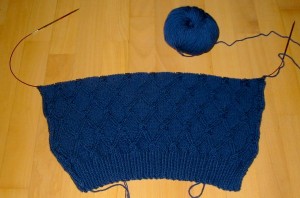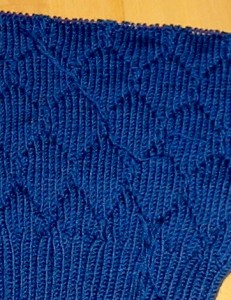Another ball of wool
 Da ich ja schon seit vor Ostern an dem Pulli stricke bin ich inzwischen natürlich ein Stück weiter. (Mit dem Posten von dem Pulli bin ich definitiv hinten dran, aber ich gebe mir Mühe, aufzuholen und künftig aktueller zu berichten.)
Da ich ja schon seit vor Ostern an dem Pulli stricke bin ich inzwischen natürlich ein Stück weiter. (Mit dem Posten von dem Pulli bin ich definitiv hinten dran, aber ich gebe mir Mühe, aufzuholen und künftig aktueller zu berichten.)
Das erste Knäuel gab ja nicht mehr so viel her. Nach den ganzen Maschenproben reichte es kaum über das Bündchen hinaus.
Mit dem zweiten kam ich dann doch schon weiter, wie man sieht. Nicht so gut gefiel mir allerdings der Knoten im zweiten Knäuel. Das ist jetzt nicht so ganz die Qualität, die ich schätze. Mal sehen, wie das weitergeht…
As I started this sweater before Easter there is of course some progress since then. (I’m a bit behind with my postings of my knitting, but I’m trying to catch up and being more up to date in the future.)
What was leftover from my first ball after the swatching didn’t bring me far, just the cuff and two more rows. That was it then.
The second ball did bring me much further, as the picture shows. What I was less happy with is the fact, that the yarn was broken and the ends knotted together towards the end of the ball. That is actually not the quality of yarn I prefer. So I hope this will not happen on every second ball…
 Außerdem habe ich mal eine neue Technik ausprobiert, das Garn des neuen Knäuels anzuknüpfen.
Außerdem habe ich mal eine neue Technik ausprobiert, das Garn des neuen Knäuels anzuknüpfen.
Bisher habe ich immer einfach aufgehört, ein neues Knäuel angefangen und dann eben die Enden vernäht. Bei Socken habe ich auch schon mal einfach Ende vom einen und Anfang vom nächsten Knäuel miteinder verdrillt und dann über einige Maschen beide Fäden zusammengestrickt. Für einen Pulli will mir das jedoch nicht gefallen, ein bißchen sieht man es doch.
Ich habe aber auch Anleitungen gesehen (ich kann mir dummerweise nie merken, wo ich was gefunden habe, deswegen kann ich auch nie nachgucken, wie es genau ging), bei denen der Faden geteilt wird, dann die Hälfte vom alten mit der Hälfte vom neuen Garn zusammengedreht wird und dann einige Maschen mit diesem „halb-halb“ Garn gestrickt werden, bevor man ganz auf das neue Knäuel wechselt.
Gut, das funktioniert… aber wo der Vorteil ist, erschließt sich mir nicht ganz. Jetzt habe ich auf der Rückseite halt zwei Mal zwei halbe Faden, statt zwei Mal einen ganzen Faden zum Vernähen. Da fehlt mir wohl noch der entscheidende Punkt?
Also I decided to try a new technique for joining the new ball.
So far I had just stopped at the end of one ball when the yarn got to short and knitted the next stitch with the new ball. And at the end I had to weave in the ends, of course. On socks often I just twisted both ends over some centimeters and knit some stitches with that „double yarn“. For socks okay, but not for a sweater, because it remains a bit visible.
Sometime ago I’ve seen somewhere (I never remember where I’ve found something, I just remember the facts, so I can not look again, what it was exactely) another techniques: You untwist the end of both balls and separate them into two strands each. the you twist together one half of the old ball and the other half of the new ball and knit some stitches with that newly twisted yarn before you go on with the new ball alltogether. Well, that works nicely, but I must have missed the point somewhere. Instead of two dangling strands of yarn I have four half strands of yarn dangling. (And to weave in at the end.) So, what’s the point?
